
Posted on November 27, 2018
In this week’s ‘You Ask, We Investigate’ report, KNWA’s Katelynn Zoellner spoke with officials to get an update on a project happening at Lake Sequoyah in Fayetteville.
Lake Sequoyah is comprised of approximately 1,400 acres of land and 389 acres of water. The City of Fayetteville purchased the property in 1958, and the lake was originally constructed in 1961 as a water supply reservoir. The city stopped using Lake Sequoyah as a water supply soon after Beaver Lake was completed, and the Beaver Water District became the primary source of water for Northwest Arkansas. The construction of Lake Sequoyah added a significant additional benefit to the community and local water environment.
There is a large amount of sediment from the Middle Fork White River that has accumulated within the lake instead of being deposited into Beaver Lake, several miles downstream. Because of this large sediment accumulation, many of the long-term uses of the lake have been compromised or reduced, including the ability of the lake to continue accumulating additional sediment.
The lake is being dredged to effectively re-establish the lake as a sediment catchment and recreational resource.
“I think it’s important to know removing the sediment from Lake Sequoyah is doing a much bigger thing than anyone realizes,” said Tim Nyander, Utilities Director in City of Fayetteville.
Removal of the sediment will also remove the phosphorus bound in the sediment. Phosphorus is an essential nutrient for plants, but too much phosphorus in the water causes algae to grow faster than the ecosystems can handle. Significant increases in algae harm water quality, food resources and habitats, and decrease the oxygen that fish and other aquatic life need to survive.
“We are going to be able to prevent the phosphorus from getting into Beaver Lake, which is the region’s water supply,” said Nyander. “So, we want to dredge it out not only to remove phosphorus, but to also have more recreation activity.”
The initial construction was completed in three phases. The first phase included the construction of a force main pipeline to carry the separated water to the sanitary sewer for treatment at the wastewater treatment plant. The second phase consisted of installing span bridges to cross two sensitive areas; one wetland crossing and one stream crossing. Phase three, which was completed this year, focused on construction of highway access and access roads between the different work areas, as well as construction of the basin in which the dewatering activities will take place.
The next phase of the project will be to purchase a lake dredging unit, a portable booster pump and a dewatering structure, called a geo-pool. The dredge will pump a sediment slurry from the lake to the booster pump on the shoreline. The booster pump will discharge into a line carrying the sediment slurry into the geo-pool. The solids will be separated in the geo-pools at this point. The remaining water that passes through the screened walls of geo-pool will be discharge through the force-main built in the first phase of the project. The sediment will be allowed to dry, and then used as a soil amendment.
“I know what people see when they’re driving past is the building of a road and bridges, but it’s all getting ready for the project,” said Nyander. “Once it begins, they will not see a whole lot, but we will be doing a big thing to help the community.”
The timeline for the dredging project is 10-15 years. It is expected to start in the next year or two.
Is there something in your community that you want to know more about, we want to investigate it.
Source: nwa





